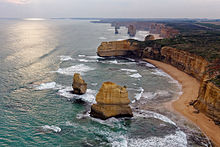
Back مسلة بحرية Arabic Кекур Bulgarian Faralló Catalan Brandungspfeiler German Klifinsuletoj Esperanto Stack (geomorfología) Spanish Stack (geologia) Basque صخره دریایی Persian Stack (géologie) French Brâningspylder Frisian
This article needs additional citations for verification. (August 2015) |

A stack or sea stack is a geological landform consisting of a steep and often vertical column or columns of rock in the sea near a coast, formed by wave erosion.[1] Stacks are formed over time by wind and water, processes of coastal geomorphology.[2] They are formed when part of a headland is eroded by hydraulic action, which is the force of the sea or water crashing against the rock. The force of the water weakens cracks in the headland, causing them to later collapse, forming free-standing stacks and even a small island. Without the constant presence of water, stacks also form when a natural arch collapses under gravity, due to sub-aerial processes like wind erosion. Erosion causes the arch to collapse, leaving the pillar of hard rock standing away from the coast—the stack. Eventually, erosion will cause the stack to collapse, leaving a stump. Stacks can provide important nesting locations for seabirds, and many are popular for rock climbing.
Isolated steep-sided, rocky oceanic islets typically of volcanic origin, are also loosely called "stacks" or "volcanic stacks".
- ^ Easterbrook, D. J. (1999). Surface Processes and Landforms. Upper Saddle River, New Jersey: Prentice Hall. p. 442. ISBN 0-13-860958-6.
- ^ "Sea stacks" britannica.com Archived 2009-04-14 at the Wayback Machine